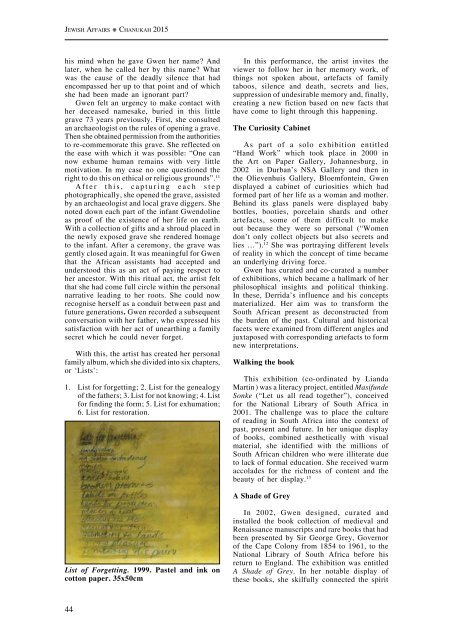J A
Jewish-Affairs-Chanukah-2015
Jewish-Affairs-Chanukah-2015
Create successful ePaper yourself
Turn your PDF publications into a flip-book with our unique Google optimized e-Paper software.
JEWISH AFFAIRS Chanukah 2015<br />
his mind when he gave Gwen her name? And<br />
later, when he called her by this name? What<br />
was the cause of the deadly silence that had<br />
encompassed her up to that point and of which<br />
she had been made an ignorant part?<br />
Gwen felt an urgency to make contact with<br />
her deceased namesake, buried in this little<br />
grave 73 years previously. First, she consulted<br />
an archaeologist on the rules of opening a grave.<br />
Then she obtained permission from the authorities<br />
to re-commemorate this grave. She reflected on<br />
the ease with which it was possible: “One can<br />
now exhume human remains with very little<br />
motivation. In my case no one questioned the<br />
right to do this on ethical or religious grounds”. 11<br />
After this, capturing each step<br />
photographically, she opened the grave, assisted<br />
by an archaeologist and local grave diggers. She<br />
noted down each part of the infant Gwendoline<br />
as proof of the existence of her life on earth.<br />
With a collection of gifts and a shroud placed in<br />
the newly exposed grave she rendered homage<br />
to the infant. After a ceremony, the grave was<br />
gently closed again. It was meaningful for Gwen<br />
that the African assistants had accepted and<br />
understood this as an act of paying respect to<br />
her ancestor. With this ritual act, the artist felt<br />
that she had come full circle within the personal<br />
narrative leading to her roots. She could now<br />
recognise herself as a conduit between past and<br />
future generations. Gwen recorded a subsequent<br />
conversation with her father, who expressed his<br />
satisfaction with her act of unearthing a family<br />
secret which he could never forget.<br />
With this, the artist has created her personal<br />
family album, which she divided into six chapters,<br />
or ‘Lists’:<br />
1. List for forgetting; 2. List for the genealogy<br />
of the fathers; 3. List for not knowing; 4. List<br />
for finding the form; 5. List for exhumation;<br />
6. List for restoration.<br />
In this performance, the artist invites the<br />
viewer to follow her in her memory work, of<br />
things not spoken about, artefacts of family<br />
taboos, silence and death, secrets and lies,<br />
suppression of undesirable memory and, finally,<br />
creating a new fiction based on new facts that<br />
have come to light through this happening.<br />
The Curiosity Cabinet<br />
As part of a solo exhibition entitled<br />
“Hand Work” which took place in 2000 in<br />
the Art on Paper Gallery, Johannesburg, in<br />
2002 in Durban’s NSA Gallery and then in<br />
the Olievenhuis Gallery, Bloemfontein, Gwen<br />
displayed a cabinet of curiosities which had<br />
formed part of her life as a woman and mother.<br />
Behind its glass panels were displayed baby<br />
bottles, booties, porcelain shards and other<br />
artefacts, some of them difficult to make<br />
out because they were so personal (“Women<br />
don’t only collect objects but also secrets and<br />
lies …”). 12 She was portraying different levels<br />
of reality in which the concept of time became<br />
an underlying driving force.<br />
Gwen has curated and co-curated a number<br />
of exhibitions, which became a hallmark of her<br />
philosophical insights and political thinking.<br />
In these, Derrida’s influence and his concepts<br />
materialized. Her aim was to transform the<br />
South African present as deconstructed from<br />
the burden of the past. Cultural and historical<br />
facets were examined from different angles and<br />
juxtaposed with corresponding artefacts to form<br />
new interpretations.<br />
Walking the book<br />
This exhibition (co-ordinated by Lianda<br />
Martin ) was a literacy project, entitled Masifunde<br />
Sonke (“Let us all read together”), conceived<br />
for the National Library of South Africa in<br />
2001. The challenge was to place the culture<br />
of reading in South Africa into the context of<br />
past, present and future. In her unique display<br />
of books, combined aesthetically with visual<br />
material, she identified with the millions of<br />
South African children who were illiterate due<br />
to lack of formal education. She received warm<br />
accolades for the richness of content and the<br />
beauty of her display. 13<br />
A Shade of Grey<br />
List of Forgetting. 1999. Pastel and ink on<br />
cotton paper. 35x50cm<br />
In 2002, Gwen designed, curated and<br />
installed the book collection of medieval and<br />
Renaissance manuscripts and rare books that had<br />
been presented by Sir George Grey, Governor<br />
of the Cape Colony from 1854 to 1961, to the<br />
National Library of South Africa before his<br />
return to England. The exhibition was entitled<br />
A Shade of Grey. In her notable display of<br />
these books, she skilfully connected the spirit<br />
44


